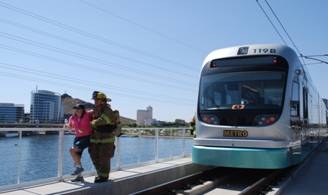ADOT serves as safety oversight for rail transit
ADOT serves as safety oversight for rail transit

Firefighters and other emergency crews participated in a mock emergency near Tempe Town Lake. The drill was conducted by METRO.
There’s so much to be said for rail transit – the future of this efficient mode of transportation is pretty exciting.
In Arizona steps are being taken toward that future with the operation of METRO Light Rail and the anticipated launch of Tucson ’s modern streetcar project.
While ADOT is not responsible for rail transit in the state, the agency does play an important role …
Back in the early 1990s, work began on a federal level to establish a method of ensuring the safety and security of rail transit. That led to the Federal Transit Administration’s creation of the State Safety Oversight Rule in 1995. It sets forth requirements to improve rail transit safety and security and gives the states the authority to take on oversight.
That’s where ADOT comes in.
ADOT’s Herman Bernal is the state safety oversight manager for transit (that doesn’t include buses, by the way). He works with METRO Light Rail to make sure the ride is safe and secure for all passengers.
His duties are spelled out by the federal rule, and include:
- Developing a system safety program standard
- Reviewing, approving and monitoring the implementation of that plan
- Requiring each rail transit system to report the occurrence of accidents and unacceptable hazardous conditions
- Conducting onsite visits
- Requiring the rail transit system to conduct safety audits
His job also includes lots of training, workshops and conferences, which help make him aware of the potential safety and security threats faced by rail transit. The FTA conducts training for him and his counterparts twice a year.

Participants acted injured and confused so emergency crews could practice what it would be like to evacuate a METRO Light Rail car.
There have been two recent training scenarios that METRO has conducted and Bernal was on hand for. One scenario was conducted near on the Tempe Town Lake bridge and let local emergency responders practice how they would react if a METRO Light Rail passenger car was on fire and needed to be evacuated (see photos in this post).
Volunteers acted as passengers who were injured and confused. Bernal said there were many different scenarios thrown at the responders – including crowd control and the possibility of live electricity in the cars.
An earlier training exercise focused on what to do in case of a derailment.
“We had three shifts of firefighters going through the mock derailment,” said Bernal, adding 911 dispatchers, ambulance companies and police from Mesa, Tempe, Scottsdale and Phoenix were involved, too.
Jay Harper, METRO’s chief of safety and security, says the scenarios are beneficial and two are required each year.
“It’s a very collaborative relationship I think,” Harper said of ADOT’s safety oversight role. “We both understand what we need to do and we understand how important it is that we do it correctly.”
Bernal agrees and says METRO has done a phenomenal job and that the growing system is important to Arizona ’s future.
“In 10 to 20 years our population could double,” he said. “If we don’t look at light rail and street cars, we’re going to miss the boat."

